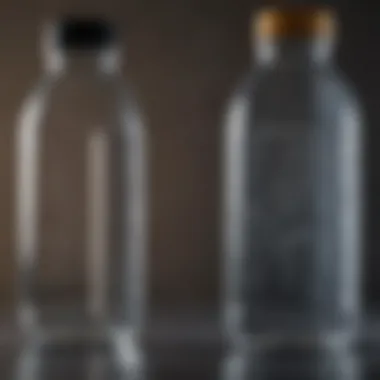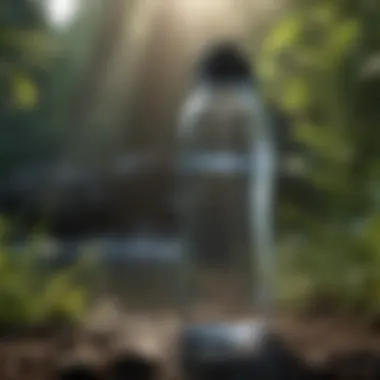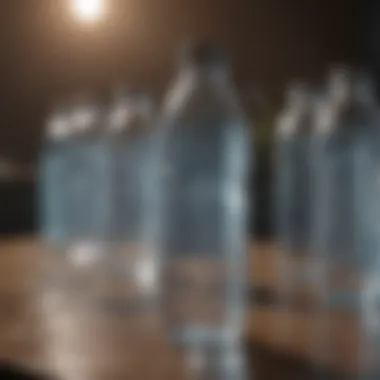Discover the Ultimate Guide to Non-Toxic Water Bottles: A Comprehensive Overview


Strategies for Selecting the Best Non-Toxic Water Bottle
When embarking on the journey of finding the ideal non-toxic water bottle, it's crucial to set clear goals. Setting specific objectives will guide your search towards options that align with your values and requirements. Effective goal setting entails defining the materials you want to avoid, such as BPA or phthalates, and prioritizing sustainability and health.
Time management plays a vital role in the selection process. Allocating dedicated time for research allows you to explore the wide array of non-toxic water bottle options available. By efficiently managing your time, you can thoroughly assess the materials, features, and reviews to make an informed decision.
Productivity hacks can streamline your search for the perfect non-toxic water bottle. Utilizing comparison charts, bookmarking relevant websites, and note-taking can enhance your productivity levels. These hacks enable you to efficiently gather and evaluate information, making the selection process smoother and more efficient.
As we embark on a journey to explore non-toxic water bottles, we delve into a realm that goes beyond simple hydration. In a world where environmental consciousness and personal health are paramount, the choice of a water bottle can make a significant difference. This comprehensive guide aims to shed light on the importance of opting for safe and eco-friendly options, guiding readers towards informed decisions that align with their values and requirements.
Understanding Non-Toxic Water Bottles
Definition of Non-Toxicity
In the realm of water bottles, the term 'non-toxic' holds immense significance. It refers to the absence of harmful substances like BPA, phthalates, or lead, ensuring that the container does not leach toxins into the contents. Non-toxic materials are chosen for their purity and safety, making them a preferred choice for health-conscious individuals. The key characteristic of non-toxicity lies in its assurance of purity and safety, eliminating the risks associated with harmful chemicals commonly found in plastic containers. By opting for non-toxic materials, individuals mitigate health risks and contribute positively to environmental sustainability.
Significance of Non-Toxic Materials
The significance of non-toxic materials lies in their positive impact on both personal well-being and the environment. By selecting water bottles made from non-toxic materials, individuals reduce their exposure to harmful chemicals, promoting better health outcomes. Additionally, non-toxic materials play a vital role in minimizing environmental pollution, ensuring that the lifecycle of the bottle does not contribute to plastic waste accumulation. The unique feature of non-toxic materials is their ability to maintain purity and safety, offering a durable and eco-conscious alternative to conventional plastic bottles.
Environmental Impact
Plastic Pollution
Plastic pollution stands as a stark reality in today's world, with single-use plastic items accounting for a significant portion of environmental waste. Water bottles made from conventional plastics contribute to this pollution, posing threats to marine life and ecosystems. The key characteristic of plastic pollution lies in its persistence in the environment, taking hundreds of years to decompose fully. Opting for non-toxic alternatives helps in reducing plastic waste and lessening the burden on the environment. By choosing sustainable materials, individuals actively participate in ameliorating the detrimental effects of plastic pollution.
Sustainable Alternatives
Amidst the crisis of plastic pollution, sustainable alternatives emerge as beacons of hope. Materials like stainless steel, glass, and bamboo offer eco-friendly options for water bottle construction. The key characteristic of sustainable alternatives is their ability to be reused and recycled, minimizing resource depletion and waste generation. By opting for water bottles crafted from sustainable materials, individuals contribute to a circular economy, where products are designed to have a minimal impact on the environment. The unique feature of sustainable alternatives is their versatility and durability, providing long-term solutions to the pressing issue of plastic pollution.
Materials
In this in-depth exploration of non-toxic water bottles, the section on materials plays a pivotal role in guiding consumers towards safe and eco-friendly choices. When considering the significance of materials in the context of non-toxicity, it becomes apparent that the key lies in selecting options that are free from harmful chemicals like BPA and other contaminants. The materials used in water bottles determine factors such as durability, safety, and environmental impact. By focusing on materials, consumers can make informed decisions that align with their health and sustainability goals.


Common Non-Toxic Materials
Stainless Steel
Stainless steel emerges as a prominent choice in the realm of non-toxic materials due to its inert nature and resistance to corrosion. The key characteristic of stainless steel is its durability, ensuring that the water bottle remains free from potential contaminants over time. Additionally, stainless steel is lauded for its recyclability, making it an environmentally sound option for conscious consumers. Despite its slightly heavier weight compared to other materials, the longevity and purity of stainless steel make it a highly sought-after choice for non-toxic water bottles.
Glass
Glass stands out as a classic yet dependable material for non-toxic water bottles, offering unparalleled purity and neutrality in taste. The key characteristic of glass is its transparency, allowing users to assess the cleanliness of the bottle with ease. While glass may be perceived as fragile, advancements in manufacturing techniques have resulted in the production of durable and shatter-resistant glass bottles. Moreover, glass is entirely free from chemicals like BPA, providing a safe and clean container for holding liquids.
Bamboo
Bamboo presents itself as a unique and environmentally friendly material for non-toxic water bottles, reflecting a sustainable approach to container design. The key characteristic of bamboo is its biodegradability, ensuring minimal environmental impact at the end of its lifecycle. Bamboo is also a lightweight material, ideal for users seeking portable and eco-conscious hydration options. However, it is essential to note that bamboo bottles may require specific care to maintain their integrity, as exposure to excessive moisture could compromise their longevity.
Safety Certification
In the realm of non-toxic water bottles, safety certifications play a crucial role in assuring consumers of the product's adherence to quality and health standards. By examining safety certifications like FDA approval and BPA-Free labels, consumers can make informed decisions regarding the products they choose to purchase. These certifications act as indicators of the bottle's safety for holding beverages, especially when it comes to storing water for extended periods. When considering non-toxic water bottles, prioritizing options with relevant safety certifications can enhance consumer confidence and trust in the product.
FDA Approval
FDA approval signifies that a water bottle has undergone rigorous testing to ensure its safety for consumer use. The key characteristic of FDA approval is its regulatory backing, indicating that the bottle meets the necessary health standards set by the Food and Drug Administration. This assurance of compliance with established guidelines makes FDA-approved water bottles a reliable choice for individuals looking to prioritize their health and well-being.
BPA-Free
The term 'BPA-Free' has become synonymous with non-toxic products, particularly in the context of water bottles. Highlighting the absence of Bisphenol A, a chemical compound often found in plastics, BPA-Free labels assure consumers that the bottle does not leach harmful substances into the contents. The key characteristic of BPA-Free bottles is their commitment to maintaining purity and safety, making them a preferred choice for those seeking non-toxic alternatives. By opting for BPA-Free water bottles, consumers can minimize their exposure to potentially harmful chemicals, contributing to a healthier lifestyle and a cleaner environment.
Features to Look For
When exploring non-toxic water bottles, understanding the essential features to look for is crucial to make an informed decision. Leak-proof design and insulation are key elements that significantly impact the functionality and convenience of a water bottle. By delving into these features, users can ensure that their water bottle meets their specific requirements. The intricacies of leak-proof design and insulation go beyond mere convenience, as they play a vital role in maintaining the quality and safety of the contents within the bottle.
Leak-Proof Design
Importance of Leak-Proof
Leak-proof design stands as a paramount feature in non-toxic water bottles, ensuring that users can carry their beverages without the fear of spillage or leakage. The significance of leak-proof capabilities goes beyond mere convenience; it contributes to maintaining the integrity of the liquid stored within the bottle. By preventing leaks, the bottle guarantees a mess-free experience, whether used during everyday activities or outdoor adventures. The reliability of a leak-proof water bottle is a sought-after trait among users, elevating the overall usability and convenience of the product.


Sealing Mechanisms
Identifying the Best Sealing Mechanisms
Sealing mechanisms are pivotal components of leak-proof design, determining the effectiveness of preventing liquid from seeping out of the bottle. Various types of sealing mechanisms, such as screw-on caps and flip-up lids, offer different levels of security and ease of use. Assessing the unique features of each sealing mechanism allows users to select one that aligns with their preferences and requirements. While some mechanisms prioritize quick access, others focus on maximum leak protection. Understanding the pros and cons of different sealing mechanisms empowers users to make an informed choice based on their lifestyle and usage patterns.
Insulation
Insulation in non-toxic water bottles serves the fundamental purpose of maintaining the temperature of liquids, whether hot or cold. This feature adds a layer of versatility to the bottle, allowing users to enjoy their preferred temperature of beverage for extended periods. By considering the insulation capacity of a water bottle, individuals can choose a product that caters to their specific needs and preferences. The effectiveness of insulation contributes significantly to the overall user experience, particularly for those who require their beverages to stay at a consistent temperature throughout the day.
Maintaining Temperature
Impact of Maintaining Temperature
The ability of a water bottle to maintain the temperature of its contents is a game-changer for users looking to enjoy hot or cold beverages on the go. Whether it's a piping hot coffee in the morning or an ice-cold refreshment on a sunny day, the maintenance of temperature ensures that every sip is as enjoyable as the first. This feature elevates the utility of non-toxic water bottles, offering a practical solution for individuals with specific temperature preferences. The convenience of having a beverage at the desired temperature, even hours after filling the bottle, enhances the overall user satisfaction and utility of the product.
Double-Walled Construction
Advantages of Double-Walled Construction
Double-walled construction plays a pivotal role in enhancing the insulation properties of water bottles. By creating a barrier between the inner and outer layers of the bottle, this design reduces heat transfer, effectively maintaining the temperature of the liquid inside. The insulating properties of double-walled construction are especially beneficial for users who require their beverages to remain at a consistent temperature for prolonged periods. Additionally, the durability and robustness offered by this construction add value to the water bottle, ensuring long-lasting performance and enhanced user experience.
Cleaning and Maintenance
In the realm of non-toxic water bottles, understanding the importance of cleaning and maintenance is paramount to ensuring the longevity and safety of these products. Proper cleaning not only preserves the integrity of the materials but also helps in preventing any potential health hazards that may arise from contamination. Maintenance practices play a crucial role in upholding the quality and performance of the water bottle, making it a crucial aspect for consumers to consider.
Cleaning Techniques
Handwashing
Discussing the method of handwashing as a means of cleaning non-toxic water bottles brings to light the meticulous care required to maintain cleanliness. Handwashing allows for a thorough and personalized cleaning approach, enabling individuals to reach all nooks and crannies that a dishwasher might miss. The careful attention to detail that handwashing provides ensures that any residue or impurities are effectively removed, contributing to the overall safety and hygiene of the water bottle. While time-consuming, handwashing proves to be a popular choice for those who prioritize a thorough clean in a gentle manner.
Dishwasher Safe
Highlighting the dishwasher-safe feature showcases a convenient cleaning option for individuals seeking a time-saving and efficient cleaning method. The characteristic of being dishwasher safe indicates that the water bottle can withstand the dishwasher's heat and pressure without compromising its structural integrity or safety. This feature proves to be popular among busy individuals or those who prefer a hassle-free cleaning process. However, it is essential to note any specific instructions or precautions provided by the manufacturer to ensure the water bottle remains in optimal condition despite repeated dishwasher usage.


Avoiding Contamination
Regular Cleaning
Regular cleaning serves as a proactive measure to prevent contamination and maintain the hygiene of non-toxic water bottles. By incorporating regular cleaning routines into daily habits, individuals can reduce the risk of harmful bacteria buildup and other contaminants. The consistency of regular cleaning not only ensures a safe drinking experience but also prolongs the lifespan of the water bottle. This beneficial practice aligns with the overall goal of promoting a healthy and sustainable lifestyle through conscientious bottle maintenance.
Storage Tips
Discussing practical storage tips underscores the significance of proper storage in preserving the quality of non-toxic water bottles. Proper storage techniques, such as keeping the bottles in a well-ventilated area away from direct sunlight or heat sources, help prevent mold growth and maintain the bottle's freshness. By implementing efficient storage practices, individuals can prolong the usability of their water bottles and minimize the risk of contamination. These storage tips serve as a valuable addition to the overall cleaning and maintenance routine, contributing to the long-term durability and performance of non-toxic water bottles.
Buying Guide
In the realm of non-toxic water bottles, the buying guide serves as a crucial compass for consumers navigating through the myriad of options available. It plays a pivotal role in aiding individuals in making informed decisions regarding their water bottle choices. By understanding the factors associated with different non-toxic materials, safety certifications, and features, buyers can select the most suitable bottle that aligns with their values and requirements.
Factors to Consider
Size and Capacity
When diving into the considerations for non-toxic water bottles, size and capacity emerge as fundamental aspects to ponder upon. The size and capacity of a water bottle dictate its usability and functionality. Opting for a bottle that accommodates your daily hydration needs ensures convenience and efficiency in carrying water on-the-go. The provision of various size options enables users to tailor their choice according to personal preferences, whether it be for short outings or long outdoor adventures. Understanding the relationship between size and capacity aids buyers in selecting the ideal water bottle that seamlessly integrates into their lifestyle.
Lid Types
Another pivotal element to contemplate while exploring non-toxic water bottles is the diversity in lid types. The lid of a water bottle contributes significantly to its usability and user experience. Different lid styles such as screw-on, flip-top, or straw lids offer varying levels of convenience and accessibility. The choice of lid type can influence the ease of drinking, spill resistance, and overall functionality of the bottle. By delving into the unique features of each lid type, consumers can pinpoint the one that best aligns with their preferences and usage requirements.
Portability
Portability stands out as a key consideration for individuals seeking a non-toxic water bottle that seamlessly integrates into their daily routines. The portability of a water bottle encompasses its ease of transport, lightweight nature, and compatibility with different environments. Whether you are a frequent traveler, a fitness enthusiast, or an office professional, having a portable water bottle at hand ensures hydration accessibility wherever you go. Assessing the portability features of different bottles allows users to select a travel companion that complements their activities and lifestyle seamlessly.
Top Non-Toxic Brands
Hydro Flask
Among the premier names in the realm of non-toxic water bottles, Hydro Flask stands out for its commitment to quality, innovation, and sustainability. Boasting superior insulation capabilities, durable construction, and a range of sleek designs, Hydro Flask offers a premium hydration experience for users. The brand's dedication to environmental stewardship and product durability cements its position as a top choice for individuals prioritizing both performance and sustainability in their water bottle selection.
Klean Kanteen
Klean Kanteen stands as a beacon of excellence in delivering non-toxic water bottles that marry functionality with eco-conscious practices. With a focus on stainless steel craftsmanship, versatile lid options, and a diverse product line catering to various preferences, Klean Kanteen captures the essence of reliability and sustainability. The brand's emphasis on reducing single-use plastic waste and promoting reusable solutions resonates with eco-conscious consumers seeking durable and non-toxic hydration solutions.
S'well
S'well emerges as a frontrunner in the realm of non-toxic water bottles, exuding elegance, style, and eco-friendly innovation. Renowned for its double-walled stainless steel construction, vibrant designs, and mission-driven initiatives, S'well embodies the fusion of fashion and function in each bottle. The brand's collaboration with charity partners to support clean water initiatives globally enhances its appeal to socially conscious consumers looking to make a meaningful impact through their everyday choices.



